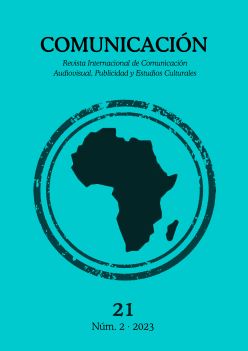Resumen
This article studies the genesis of Sembene Ousmane's cinema during the early years of Senegal's independence. Sembene was a renowned anti-colonial Senegalese writer who shifted to filmmaking during the "independence interlude" spanning 1960 to 1965, with his first film Borom Sarret (1963). He became a pioneer of African cinema. Sembene revolutionary filmmaking and radical artistic project catapulted him to the pantheon of worldwide filmmakers. Drawing from postcolonial film criticism, this article focuses on two of Sembene's pioneering films: Borom Sarret and Niaye. I argue that Sembene strategically crafted these films to genuinely contribute to the collective effort of postcolonial reconstruction. I start with a brief review of Sembene's literary works during the independence interlude to understand how this period influenced his artistic perspective and cinematic narrative regarding gender. I then dive into the analysis of masculinity and colonial legacy in Borom Sarret and finally focus on Niaye to study how Sembene depicts the collective memory and patriarchal dynamics in a pseudo-feudal society in transition from colonialism to independence, tradition to modernity. The article contributes to a better understanding of how Sembene approached social transformation, navigated (post)colonial power structures shaped by colonial and ancestral legacies, and established himself as an iconoclastic artist.
Citas
Andrade-Watkins, C. (1993). Film production in Francophone Africa 1961 to 1977: Ousmane Sembène – An Exception. In S. Gadjigo et al. (Eds.), Ousmane Sembène, Dialogues with Critics and Writers (pp. 29-38). University of Massachusetts Press.
Bâ, A. H. (1976). En Afrique cet art où la main écoute. Le courrier.
Bensmaïa, R. (2007). A cinema of Cruelty. In J. Rouch & J. Ten Brink (Eds.), Building Bridges (pp. 73-85). Wallflower.
Bidima, J.-G. (2002). Introduction. De la Traversée : Raconter des Expériences, Partager le Sens.
Collège international de Philosophie, 2(36), 7-18.
Blanchard, P. & Korn-Brzoza, D. (2020). Décolonisations, du sang et des larmes (2 × 80 min). France.
Bouchard, V. (2012). Pour un Cinéma Léger et Synchrome. Invention d’un dispositif à L’office du film à Montréal. Presses Universitaires de Septentrion.
Busch, A. & Annas, M. (Eds.). (2008). Ousmane Sembène: Interviews. University Press of Mississippi.
Case, F. I. (1993). Aesthetics, Ideology, and Social Commitment in the Prose Fiction of Ousmane Sembène. In S. Gadjigo et al. (Eds.), Ousmane Sembène, Dialogues with Critics and Writers (pp. 3-13). University of Massachusetts Press.
Cham, M. (2008). Official History, Popular Memory: Reconfiguration of the African Past in the Films of Ousmane Sembene. Contributions in Black Studies, 11(4).
Connell, R. & Messerschmidt, J. W. (2005). Hegemonic Masculinity: Rethinking the Concept. Gender and Society, 19(6), 829-859.
Connell, R. (2016). Masculinities in Global Perspective: Hegemony, Contestation, and Changing Structures of Power. Theory and Society, 45(4), 303-318.
Crettien, C. (1985). France’s Relations with Her Former Colonies. Proceedings of the Meeting of the French Colonial Historical Society, 8, 1-8.
De Groof, M. (2010). Black Film Label. Negritude and Camera. Third Text, 24(2), 249-262.
Diagne, I. (2014). Lire et relire Sembene Ousmane. Harmattan.
Diagne, S. B. (2001). Africanité et écriture en Français.
Diawara, M. (1988). Popular Culture and Oral Traditions in African Film. Film Quarterly, 41(3), 6-14.
Diawara, M. (1992). African Cinema: Politics and Culture. Bloomington, Indiana University Press.
Diop, S. (2020). Sociopolitical Representations in African Cinema. Africa Development/Afrique et Développement, 45(2), 89-102.
Djiré, I. B. (1979). Mémoire de fin de d’étude : Recherches sur le Koteba. École Normale Supérieure de Bamako.Fofana, A. T. (2012). The Films of Ousmane Sembène: Discourse, Politics, and Culture. Cambria Press.
Gadjigo, S. et al. (1993). Ousmane Sembène, Dialogues with Critics and Writers. University of Massachusetts Press.
Gadjigo, S. (2010). Ousmane Sembène: The Making of a Militant Artist. Indiana University Press.
Genova, J. E. (2020). Cinema and the Struggle to (De)colonize the Mind in French/Francophone West Africa (1950s-1960s). The Journal of the Midwest Modern Language Association, 39(1), 50-62.
Mazrui, A. (1965). Sacred Suicide. Transition, 21, 10-15.
Mbembe, A. (2001). On the Postcolony. University of California Press.
Moore, C. D. (1973). Evolution of an African Artist: Social Realism in the Works of Ousmane Sembène [PhD dissertation]. Indiana University.
Mortimer, R. A. (1969). Ousmane Sembene and the Cinema of Decolonization. African Arts, 5(3), 26-27+64-68+84.
Murphy, D. (2001). Sembene: Imagining Alternatives in Film and Fiction. Africa World Press.
Oyono-Mbia, G. (1960). Trois prétendants... un mari. Pocket.
Pfaff, F. (1984). The Cinema of Ousmane Sembene, a Pioneer of African Film. Greenwood Press.
Quintero, R. (2007). A Companion to Satire. Blackwell.
Russell, S. A. (1998). Guide to African Cinema. Greenwood Press.
Sawadogo, B. (2019). West African Screen Media: Comedy, Series, and Transnationalization. Michigan State University.
Sikounmo, H. (2010). Ousmane Sembène: Écrivain populaire. Harmattan.
Sow, F. B. (1985). Muslim Families in Contemporary Black Africa. Current Anthropology, 26, 563-570.
Stam, R. (2000). Film Theory: An Introduction. Blackwell.
Ukadike, N. F. (2002). Questioning African Cinema: Conversations with Filmmakers. University of Minnesota Press.
Vetinde, L. (2011). Sex, Power, and Community in Ousmane Sembène’s Véhi-Ciosane. Matatu— Journal for African Culture and Society, 14, 441-454.
Vieyra, P. S. (1972). Ousmane Sembène: cinéaste. Première période 1962-1971. Présence Africaine.
Weaver, H. D. (2004). The Contestation of African Cinema: The Early post-Independence Filmmaking of Sembene Ousmane and his Courageous Afro-centric Colleagues. Présence Africaine, 2(170).

Esta obra está bajo una licencia internacional Creative Commons Atribución-NoComercial-CompartirIgual 4.0.
Derechos de autor 2023 Saiba Bayo

